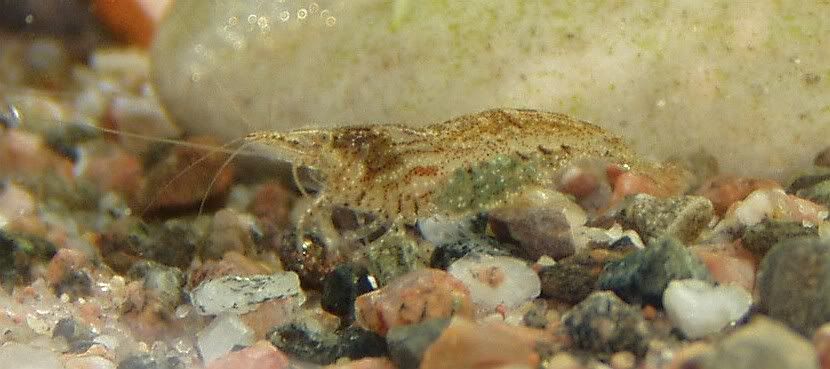Page 1 of 1
Shrimp ID
Posted: Wed Jun 01, 2005 6:40 am
by thapsus
Hello to all.

What's this shrimp?

Thanks.
Posted: Wed Jun 01, 2005 6:50 am
by Mustafa
Judging from the rostrum, eggs and patterning it looks like a Neocaridina sp. of some sort to me, could even be a mix of several Neocaridina species, subspecies or color variations. I had crossed Red Cherries with their wild form once (both Neocaridina denticulata sinensis) and some of the resulting offspring looked very similar to your animal.
Mustafa
Posted: Wed Jun 01, 2005 7:06 am
by chlorophyll
I was wondering, what is it that distinguishes Neocaridina from Caridina?
Does N.d. sinensis ever crossbreed with any common Caridina species?
Posted: Wed Jun 01, 2005 10:52 pm
by thapsus
Thanks a tons mustafa.

It's actually very likely that it's a mix. That's because I bought it with red cherrys. I just hope that dad was "real" red cherry.
Posted: Thu Jun 02, 2005 12:12 am
by jonathan03
I have a large male shrimp in with my cherry reds that looks exactly like that (minus the eggs). Could the brownish color just mean its a mature cheryr red? For example, as female cherry reds get older they turn red, so do the males become browner?
The shrimp I have that resembles the picture is larger than the male shrimp which makes me think that the colors can be from maturing. Also, the shrimp I have is not carrying eggs and never has (at least from I have seen).
I haven't had these shrimp for that long, but just a thought.
Posted: Thu Jun 02, 2005 3:14 am
by Jackie
chlorophyll wrote:I was wondering, what is it that distinguishes Neocaridina from Caridina?
I'll try to tell you what I know, but I'm translating this from Polish so I'm not sure if everything will be OK. I'm also not sure if this is proper knowlegde, as I've not checked this myself yet, only read about it.
One of the most important differences are the endopods (the ending of the first pair of the pleopods - the swimming legs). Neocaridina have round or pear shaped endopods, while Caridina have elongated ones.
Also, Neocaridina have a spike on the frontal edge of the carapax. Hope this helps, I've never looked at a shrimp under a microscope - I leave this to Paweł, my friend

chlorophyll wrote:Does N.d. sinensis ever crossbreed with any common Caridina species?
From what I know this is impossible, but you can never tell - Mother Nature CAN surprise

Posted: Thu Jun 02, 2005 9:54 am
by Mustafa
Jackie wrote:
One of the most important differences are the endopods (the ending of the first pair of the pleopods - the swimming legs). Neocaridina have round or pear shaped endopods, while Caridina have elongated ones.
You're right, Jackie, except that this is only the case in males, since these first swimming legs in males are used for reproduction (if I am not mistaken). In any case, here is a link with pictures of Neocaridina and Caridina endopods (first pic = Neocaridina, second pic = Caridina):
http://www.wirbellose.de/klotz/neocaridina.html
If you can read German, you can read the whole article which is about the distinction between Caridina and Neocaridina.
Also, Neocaridina have a spike on the frontal edge of the carapax.
Are you sure about that? I have never heard about this. This almost sounds like one of the distinguishing characteristics between Macrobrachium and Palaemonetes/Palaemon, where Macrobrachium species have a hepatic spine.
Mustafa
Posted: Thu Jun 02, 2005 12:25 pm
by Jackie
I thought i knew that site really good, but it always manages to surprise me

Mustafa wrote:Are you sure about that? I have never heard about this. This almost sounds like one of the distinguishing characteristics between Macrobrachium and Palaemonetes/Palaemon, where Macrobrachium species have a hepatic spine.
Of coure I'm not sure, I didn't discover it myself

I'll check the source and see if i have trouble with my memory or if the source is wrong. The only trouble is that I can't remember where I found this information...

Posted: Mon Jun 06, 2005 4:24 am
by chlorophyll
Ahhh. Thanks, both.
Google translation
I wonder how did Cai verify the two were indeed different genera ... and if accurate I guess this would mean they absolutely cannot interbreed. No record of that "A revision of the genus Neocaridina" article in my university library's database.
 What's this shrimp?
What's this shrimp? 

